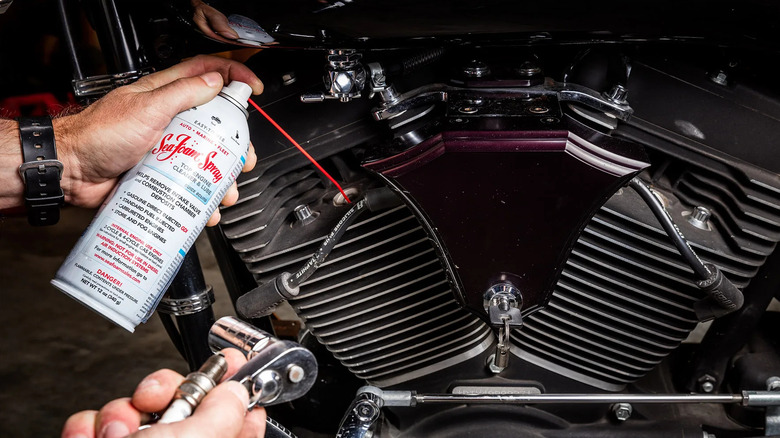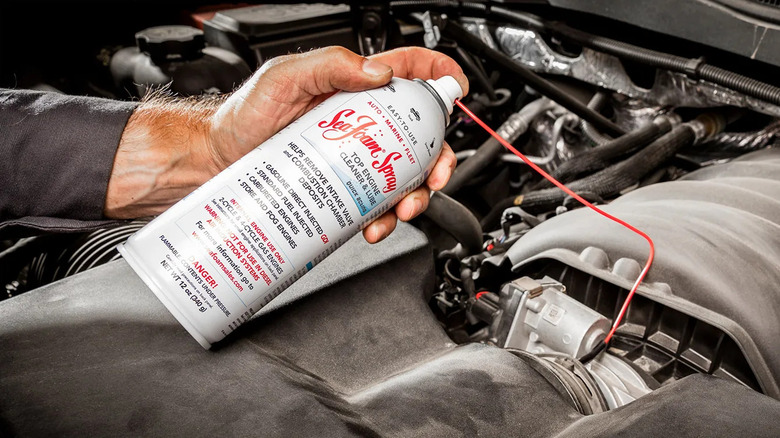What Is Sea Foam Spray And Are There Any Disadvantages Of Using It In Your Vehicle?
We may receive a commission on purchases made from links.
The Sea Foam lineup of fuel additives and engine cleaners was born out of a love for fishing, hence the name. Petroleum salesman Fred Fandrei created the first Sea Foam fuel additive in the 1930s so he could spend more time casting lines than fixing the fuel-related issues of his boat's outboard motor. The formula prevents the fuel from going bad and helps the motor run smoother and more reliably. As it turned out, the additive grew a following among Fandrei's fishing buddies and the local fishing community, and he began selling Sea Foam in beer bottles and quart jars.
Among the Sea Foam Sales Company's most well-known products is Sea Foam Spray. Unlike the original Sea Foam Motor Treatment, which you pour into the engine and fuel tank of any gasoline or diesel car, Sea Foam Spray is specifically designed for cleaning the upper engine internals and is formulated for gasoline motors only. It cleans all types of internal combustion engines, including two- and four-stroke motors, gas turbocharged, carbureted, port fuel-injected, and gasoline direct-injected (GDI) engines.
The formula enters the throttle body, a component of the engine that regulates the airflow to the intake manifold, and dissolves residue and deposits on the intake runners, intake valves, pistons, and the combustion chamber. Regular cleaning is crucial for gasoline direct-injected (GDI) engines, which are prone to developing carbon buildup. Carbon buildup can cause issues such as power loss, misfires, poor acceleration, and an illuminated check engine light in some cases.
Are there disadvantages to using Sea Foam Spray?
Sea Foam Spray is safe for all gasoline engines if used as directed. The formula contains petroleum-derived cleaning and lubricating agents that are 100% safe and won't harm vital engine parts and components. The Sea Foam Sales company addressed concerns about potentially damaging the catalytic converter and oxygen sensors on their website's help center.
According to them, the formula will not harm sensors and catalytic converters since Sea Foam Spray will vaporize with the hot exhaust after burning in the combustion chamber. However, it doesn't mean that Sea Foam Spray is ideal for cleaning or desludging the catalytic converter like other products. The company insists that Sea Foam Spray is not for cleaning the catalytic converter and should not be sprayed directly into the oxygen sensor ports.
In our opinion, the added cost is the only disadvantage of using Sea Foam Spray, although the benefits could outweigh the added expense. Starting at around $28.98 for a pack of two 14-oz. bottles at Amazon, the company recommends twice-yearly treatments for regularly driven cars and trucks with GDI engines, or possibly more for preventive maintenance.
How to use Sea Foam Spray
You'll need a few tools and some mechanical knowledge to use Sea Foam Spray, but it's not too hard. However, you'll need a buddy to help out in the process. Before doing so, it's best to start with a warm engine. Start the motor, drive the vehicle for a couple of miles to warm up the engine oil and other fluids, and park the car before turning the engine off. Engage the parking brake, raise the hood, and do the following steps:
- Remove the intake hose from the throttle body by loosening the clamps that secure it.
- Place the straw/hook guide that came with the Sea Foam Spray into the throttle body and reinsert the intake hose without removing the straw.
- With the transmission in Park (or Neutral), start the engine and press and hold the gas pedal at 2,000 rpm.
- Spray the entire contents of the Sea Foam Spray while the engine is revving to 2,000 rpm.
- Turn off the engine, remove the straw, and replace the intake hose.
- Allow the engine to hot soak for about 10 minutes after spraying.
- Start the engine and drive the vehicle for at least 10 minutes.
Moreover, Sea Foam Spray can also protect engines from rust, moisture, and contaminants during storage. The process involves removing the spark plugs, spraying Sea Foam into each cylinder cavity, and then reinserting the spark plugs.

